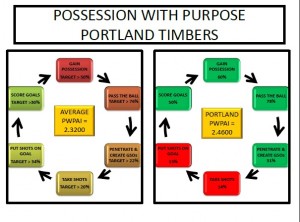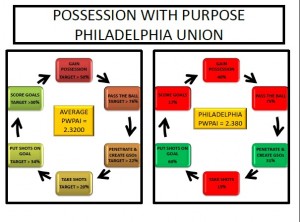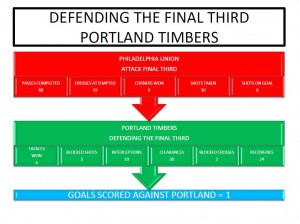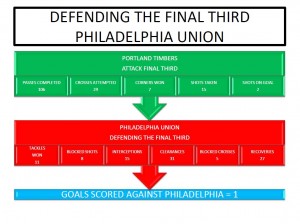Defensive battle in the rain sees the Timbers take one point in a draw with Philadelphia 1-1
Typical northwest weather greeted both teams Saturday night with neither team getting the better of the result.
In my view this was a great defensive battle as both teams looked to penetrate and generate goals; what had separated the teams for near 94 minutes was the set-piece goal by McInerney in the 64th minute before Gaston Fernandez opened his Timbers account with a late header in the 94th minute.
Wow – what a superb way to end a hard fought game that started with fireworks and ended with fireworks – well done Gaston and the Portland Timbers!
For my match thoughts, as they came out, my twitter captures what I thought were the relevant items of interest in the game. To save you the trouble of scanning through all of them here’s one a couple I picked out, with a bit more context, that I thought were relevant to the end result:
- Darlington Nagbe continues to mature in the midfield in leveraging space vacated by others as he dribble penetrates – more of Darlington executing physcial dribble-penetrations should net more shots on goal as the season progresses. Simply fantastic!
- Although Paparatto didn’t look all that comfortable last night, not many did in that pouring rain, he did make a superb, Lazarus save, in the first half. As the season progresses and he becomes more familiar with the home turf I’m sure he’ll provide more leadership. better clearances, and improved passing accuracy from his center-back position.
- In pre-match conversation with Paul Danser we both noted that the formation for Philadelphia would run a similar course to that of Portland – in other words with Edu and new additions in the midfield Hackworth would run a 4-3-3 as opposed to running the 4-4-2 that they had run all of last year.
In looking at some figures last year compared to this game here’s how the six basic PWP Index steps played out for both Portland and Philadelphia.
This is the first time I have used this new diagram – I’m not sure if it paints a representative picture but the diagram on the left shows the average MLS percentages for each of those steps in 2013; the diagram on the right shows how well the Timbers hit those targets this game; with red indicating below target and green indicating above target.
The amber box in the center gives you the combined PWP Attacking Index average for last year; not both teams (See Philadelphia diagram below) were above the 2013 MLS average.
As a reminder – 9 of the top 10 teams finishing above average in the combined PWP Index made the playoffs last year – so that target does represent what it (might?) take to attain playoff status this year.
As the season progresses this Index will expand – I will have this Index (attempt to at least) published once weekly for all teams in the MLS. I’d offer this Index will be far more accurate in offering up who is performing better or worse, as a team, than some of the other things seen elsewhere; however you view it is up to you.
As a quick observation; Portland had near 60% possession against Montreal early last year; they hit that percentage in possession again, against Philadelphia Saturday night. In short, that game was more about quantity than quality.
Last year the Philadelphia PWP AI (higher is better) last year was 2.323 (12th best) while Portland’s was 2.470 (the highest in the league). Both teams exceeded their average from last year.
Conversely; both teams finished much better in their PWP Defending Index (lower is better); Philadelphia PWP DI last night was 2.4600 while last year their average was 2.788.
For Portland, their PWP Defending Index was 2.598; in this game it was was 2.3800; hence my conclusion the game was a defensive battle. For those who don’t recall Portland had the best (lowest) Defensive PWP DI at 2.598 while Philadelphia was 13th best at 2.788. Each clearly improved their team defensive performance compared to last year.
Bottom line here is both teams should feel good about how well they defended Saturday night – and note that neither team was scored on in the run-of-play.
Now – for another new diagram (or two) this one is intended to provide some more focus on how the teams perform in the defending third (my extra research this year).
First Portland in Defense and Philadelphia in Attack:
My intent here is to capture relevant attacking information for one team compared to relevant defending information for the other team.
I have a wee bit of an idea on how this will take shape, statistics wise, but for now a simple diagram (I hope) on what positive actions Philadelphia took in attack and what corresponding positive actions Portland took in defense.
Here’s the diagram for Philadelphia in defense:
At this early stage I’m not yet ready to begin crunching numbers to submit some calculation without first observing how this data behaves over the first 15-22 games.
To draw any conclusions at this time would be inappropriate as a relative sample size has not been reached.
For now consider the intent that all the defending activities noted are those I’d initially expect to consider as a way or mean for the team to stop the opponent’s penetration and, in turn, win the ball back.
One final observation – as I noted before Philadelphia opened up in a 4-3-3 formation and ran a similar type of system as Portland – the notable difference – this was not new news for some. When looking at their overall defensive activities the one standing out to me the most was the number of defensive blocks Philadelphia had on shots taken by Portland.
All told the Union had 8 defensive blocks, snuffing out over 50% of shots taken (15) before they could even reach the goal keeper. Only two shots ended up being on target after all that – so the 50% success rate in scoring goals based upon shots on target is a bit deceptive.
Substitutions…
We had a late cameo by Steve Zakuani but given he didn’t really have much activity it’s not really appropriate to offer up thoughts other than it was good to see him on the pitch.
With respect to Kalif; looked like he had acres of space on the right side and his activity really didn’t give Portland the energy I think they needed.
All told he lost the ball in possession six times and only completed 7 of 12 passes in the 18 minutes he was on the pitch; with every pass offered from the deep right going unsuccessful.
Futty Danso did a superb job coming on for the injured Kah – he’s solid and well tuned into the game – as a player he gives you exactly what is needed… superb relief job Futty!
In closing…
For me, at this time, it’s not surprising how defensive minded this game played out – the weather (heavy rain) was an operational condition that impacted both teams.
New to Portland, perhaps, was the formation and midfield operation of Philadelphia; last year they were pretty obvious in their direct 4-4-2 attack – this game was certainly not the case as both teams opened and operated in a 4-3-3 type context.
While Edu was not particularly exciting on the pitch Saturday evening with ball, he added tremendous value off the ball. And while others may disagree I would submit Will Johnson was very focused on Edu’s presence, and that (may?) explain why I saw Diego Chara venture forward into the attacking third more than usual.
The replacement referee did a good job Saturday evening and the only observation I have is that 10 yards, on free kicks, really looked like 15 yards based upon what I saw stepped off last year. Perhaps all the referee’s will be stepping off the full 36″ step – (10 times this year) and that 10 yards this year is really what 10 yards is supposed to look like?
As I noted in my pres-season article on the Referee situation; like the players their week of work after the game will include a video session to go over and look to correct game day decision-making. This intended, and agreed to improvement, by PRO and the Referee Union will go a long way towards helping MLS “and” PRO develop better Referee’s.
All for now, Chris




